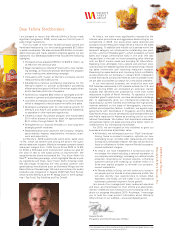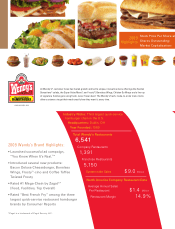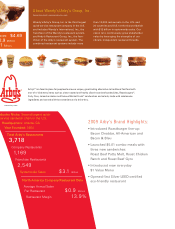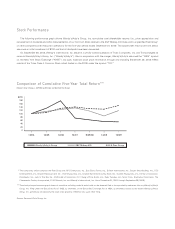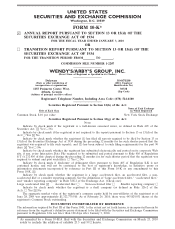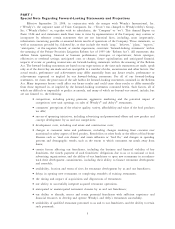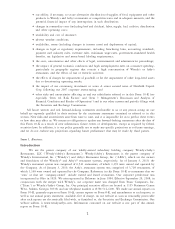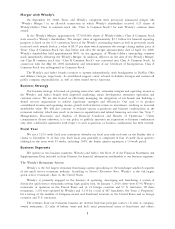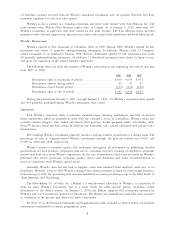Wendy's 2009 Annual Report Download - page 12
Download and view the complete annual report
Please find page 12 of the 2009 Wendy's annual report below. You can navigate through the pages in the report by either clicking on the pages listed below, or by using the keyword search tool below to find specific information within the annual report.Raw Materials and Purchasing
As of January 3, 2010, 6 independent processors (7 total production facilities) supplied all of Wendy’s
hamburger in the United States. In addition, 5 independent processors (9 total production facilities) supplied
all of Wendy’s chicken in the United States.
Wendy’s and its franchisees have not experienced any material shortages of food, equipment, fixtures or
other products that are necessary to maintain restaurant operations. Wendy’s anticipates no such shortages of
products and believes that alternate suppliers are available. Suppliers to the Wendy’s system must comply with
United States Department of Agriculture (“USDA”) and United States Food and Drug Administration (“FDA”)
regulations governing the manufacture, packaging, storage, distribution and sale of all food and packaging
products.
During the 2009 fourth quarter, Wendy’s and its franchisees entered into a purchasing co-op relationship
agreement (the “Co-op Agreement”) to establish a new Wendy’s purchasing co-op, Quality Supply Chain Co-
op, Inc. (“QSCC”). QSCC now manages food and related product purchases and distribution services for the
Wendy’s system in the United States and Canada. Through QSCC, Wendy’s and Wendy’s franchisees purchase
food, proprietary paper and operating supplies under national contracts with pricing based upon total system
volume.
QSCC’s supply chain management will facilitate continuity of supply and provide consolidated purchasing
efficiencies while monitoring and seeking to minimize possible obsolete inventory throughout the North
American supply chain. The system’s purchasing function for 2009 and prior was performed and paid for by
Wendy’s. In order to facilitate the orderly transition of the 2010 purchasing function for North American
operations, Wendy’s transferred certain contracts, assets and certain Wendy’s purchasing employees to QSCC in
the first quarter of 2010. Pursuant to the terms of the Co-op Agreement, Wendy’s is required to pay $15.5
million to QSCC over an 18 month period in order to provide funding for start-up costs, operating expenses
and cash reserves. Future operations will be funded by all members of QSCC, including Wendy’s and its
franchisees.
Trademarks and Service Marks
Wendy’s has registered certain trademarks and service marks in the United States Patent and Trademark
Office and in international jurisdictions, some of which include Wendy’s, Old Fashioned Hamburgersand
Quality Is Our Recipe. Wendy’s believes that these and other related marks are of material importance to its
business. Domestic trademarks and service marks expire at various times from 2010 to 2019, while
international trademarks and service marks have various durations of 10 to 15 years. Wendy’s generally intends
to renew trademarks and service marks that are scheduled to expire.
Wendy’s entered into an Assignment of Rights Agreement with the company’s founder, R. David
Thomas, and his wife dated as of November 5, 2000 (the “Assignment”). Wendy’s had used Mr. Thomas, who
was Senior Chairman of the Board until his death on January 8, 2002, as a spokesperson and focal point for its
products and services for many years. With the efforts and attributes of Mr. Thomas, Wendy’s has, through its
extensive investment in the advertising and promotional use of Mr. Thomas’ name, likeness, image, voice,
caricature, endorsement rights and photographs (the “Thomas Persona”), made the Thomas Persona well known
in the U.S. and throughout North America and a valuable asset for both Wendy’s and Mr. Thomas’ estate.
Under the terms of the Assignment, Wendy’s acquired the entire right, title, interest and ownership in and to
the Thomas Persona, including the sole and exclusive right to commercially use the Thomas Persona.
Seasonality
Wendy’s restaurant operations are moderately seasonal. Wendy’s average restaurant sales are normally
higher during the summer months than during the winter months. Because the business is moderately
seasonal, results for any quarter are not necessarily indicative of the results that may be achieved for any other
quarter or for the full fiscal year.
Competition
Each Wendy’s restaurant is in competition with other food service operations within the same
geographical area. The quick-service restaurant segment is highly competitive and includes well-established
competitors such as McDonald’s, Burger King, Taco Bell, Kentucky Fried Chickenand Arby’s. Wendy’s
5


